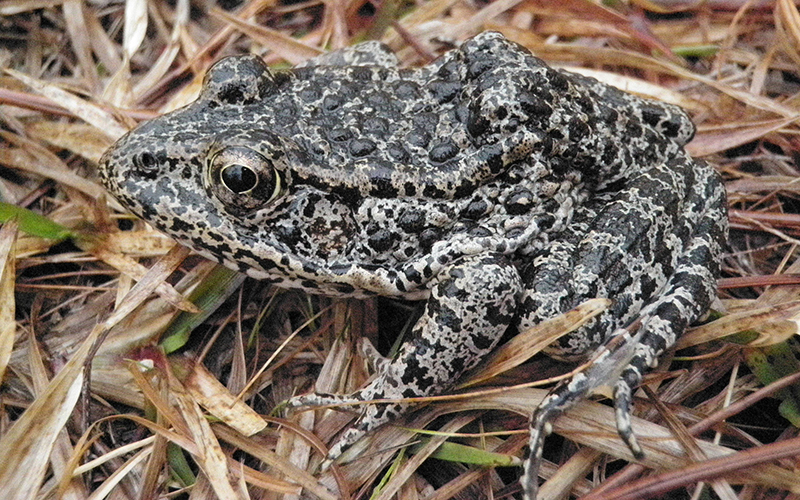
In 2001, the U.S. Fish and Wildlife Service listed the dusky gopher frog as federally endangered after a lawsuit by Tucson-based Center for Biological Diversity. (Photo courtesy U.S. Fish and Wildlife Service)
WASHINGTON – The Supreme Court made it harder Tuesday for the government to designate critical habitat for endangered species, in a ruling that business and property rights groups said corrects bureaucratic overreach.
But environmental groups criticized the unanimous decision that they said “doesn’t do any damage to the Endangered Species Act” itself, but opens the door for major setbacks in lower courts.
“Wildlife has been pushed further and further to the fringes. If endangered species are going to survive, we need to restore their habitat,” Rebecca Riley, legal director for the Nature Program of the Natural Resources Defense Council said in an email. “The Supreme Court just made that much harder to do.”
The case concerns the Fish and Wildlife Service’s decision to designate a 1,544-acre tract in Louisiana as critical habitat for dusky gopher frogs – even though no frogs lived there and it would not have been ideal habitat at the time it was designated.
The small burrowing frog was once found from coastal Louisiana to Alabama, but it was down to about 100 animals in a single Mississippi pond when it was declared endangered in 2001. Its decline was blamed on a sharp reduction in habitat it needs to survive – seasonal ponds in open-canopy pine forests.
In 2010, the government identified four Mississippi sites where the frog was living or had been re-established, but added a tract 50 miles away in St. Tammany Parish, Louisiana, to protect against a local Mississippi disaster. The Louisiana site, called Unit 1, had once been home to the frogs, but they had not been seen there since the 1960s.
As part of its review, the government determined that the habitat designation could cost the landowners up to $33.9 million in potential lost development. But the service determined the cost was reasonable and that Unit 1 – now a closed-canopy tree plantation – could be restored to suitable frog habitat with “reasonable effort.”
The Weyerhaeuser Co. and a group of family landowners sued, challenging the government’s determination that the cost was reasonable and claiming that Unit 1 could hardly be called critical habitat if it was unable to sustain the frogs.
Lower courts agreed with the government, but the Supreme Court on Tuesday reversed.
Chief Justice John Roberts wrote that the Endangered Species Act does not authorize the Interior secretary “to designate the area as critical habitat unless it is also habitat for the species.” He said lower courts need to determine if Unit 1, unoccupied and currently unsuitable for the frog, meets the definition of habitat.
The ruling also said lower courts were wrong to say they could not consider the cost analysis in the case.
A spokesman for Weyerhaeuser Co. said the company “strongly supports species conservation and the Endangered Species Act,” but it applauded the ruling that “in order for land to be deemed critical habitat, it must first be a habitat.”
The Fish and Wildlife Service declined to comment on the ruling.
But others said it would have an important impact.
“This was an important decision for property rights and for judicial oversight of agency action,” said Roger Pilon, vice president for legal affairs at the Cato institute, a libertarian think tank. “Not only was it not critical habitat, it wasn’t even habitat for the frog. It hadn’t lived there for over 50 years.
“If that rationale were allowed to stand, then there is no parcel of land in the United States that could not, with sufficient improvement, be made habitable for virtually any species. It would put the whole of the United States under the jurisdiction of the Interior Department … which is absolutely absurd,” Pilon said.
That was echoed by Rep. Paul Gosar, R-Prescott, who said the court’s ruling confirms that the “federal government has no authority to lock up private land for species that don’t habitat the land.”
But Rep. Raul Grijalva, D-Tucson, and incoming chairman of the House Natural Resources Committee, said courts “should continue to recognize the importance of the Endangered Species Act and protect the land in question.”
“The dusky gopher frog is one of the world’s most endangered species and only occupies a small fraction of its historic range,” Grijalva said in an email. “If we ever want to change that, the species will need a place to live.”
The case could affect the outcome of another court case on the critical habitat designation for jaguars in New Mexico, which also extends across several counties in Arizona.
While discouraged by the ruling, environmentalists still hold out hope for when the dusky gopher frog case returns to the 5th U.S. Circuit Court of Appeals.
“We did win before the 5th Circuit previously and the record in the case is very strong,” said Collette Adkins, senior attorney for the Center for Biological Diversity, whose 2010 lawsuit forced the Fish and Wildlife Service to designate the frog habitat.
“The ultimate question … is what does it mean to be habitats?” she said. “We’ll argue for a broad definition that would include areas that would require some habitat restoration and we think that’s consistent with the conservation purposes of the act.”
But Mark Miller, who represented the family landowners in the case, said that while “the fat lady hasn’t sung yet … this is an excellent step in the right direction.”
“Once the lower court can review it, we think that the court’s going to agree with us, that this was an arbitrary decision and that our clients shouldn’t be basically frozen by this critical habitat designation because it doesn’t protect the frog,” said Miller, senior attorney for the Pacific Legal Foundation.
Connect with us on Facebook.